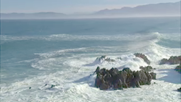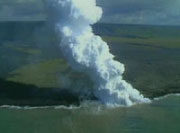 |
NASA | GSFC | JPL | Site Map |
|
|
 |
 |
Education: Student Outcomes |
Filtered by outcome: 0-4q5 Click here to begin a new search | ||||||||||||||||||||
Outcome: Explain that satellites can be used to make measurements at a distance. | ||||||||||||||||||||
Grade level: K-4 Theme: 21st century technology Video: global_ocean_01.flv
Paula Bontempi: "You can see the atmosphere, you can see the land, but you can't really see beneath the ocean's surface. So you start wondering, you know, what's going on beneath the part we can see." David Adamec: "We walk in a very small part of the atmosphere, and we walk on the land. And it's how that interaction takes place with the ocean, the atmosphere, and the land that determines our quality of life. Our goal is to understand the interconnectedness of it all." For years, people have worked to unravel the mysteries of the oceans. Scientists gather data from ships and buoys on the surface, take the plunge to explore ocean depths, and fly overhead to get a bigger picture. But one of the best views of oceans might be from way, way overhead. It's the view from space. Paula Bontempi: "The one thing that NASA satellites do that nothing else does, ships or buoys or anything else, is actually give you a picture of the globe within a few days. You get a much broader view of what's going on in some part of the Earth's system, and you can link that together to understand the Earth as a whole." Grade level: K-4 Theme: 21st century technology Video: http://ksnn.larc.nasa.gov/videos_cap.cfm?unit=studyspace
Some objects are too large to study well from the surface of the Earth. Again, hurricanes are a good example and so are earthquakes. Cracks in the Earth's crust, called faults, can cause earthquakes. Faults can be hundreds of miles long. Only satellites can see the entire fault at one time. Scientists and researchers around the world use NASA satellites. NASA's Earth Science Enterprise (ESE) and Earth Observing System (EOS) can study many natural hazards from space that can never be safely studied up close on Earth, such as fires, floods, storms, and volcanoes. Special instruments on these satellites can study hazards such as hurricanes in ways scientists can never study them on Earth. One satellite, called TRMM (Tropical Rainfall Measuring Mission), can "see" inside a hurricane. TRMM can tell that certain parts of hurricanes normally produce more rain. This information helps meteorologists forecast how much rainfall will affect people on the coast when hurricanes strike. Someday, this research may even help scientists forecast exactly where a hurricane will move onto land. Satellites allow scientists to observe remote parts of Earth that may be impossible to see except from space. Loss of trees in rainforests, the size of mountain glaciers and changes in our ozone layer can be measured best from space. | ||||||||||||||||||||

